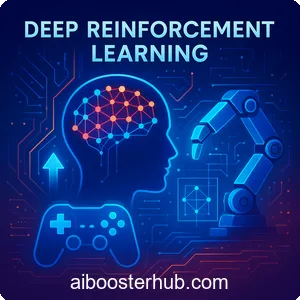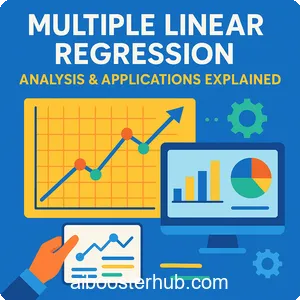Support Vector Machines (SVM): Theory and Applications
Support vector machines (SVM) represent one of the most powerful and elegant algorithms in machine learning. Despite the rise of deep learning, SVM remains a go-to choice for many classification and regression tasks, particularly when working with structured data or smaller datasets. Understanding what is SVM and how it works is essential for anyone serious about mastering machine learning fundamentals.

In this comprehensive guide, we’ll explore the theory behind the SVM algorithm, dive into its mathematical foundations, and demonstrate practical applications. Whether you’re new to SVM in machine learning or looking to deepen your understanding, this article will provide you with the knowledge and tools to effectively apply SVMs to real-world problems.
Content
Toggle1. Understanding the fundamentals of support vector machines
What is SVM?
A support vector machine is a supervised learning algorithm that analyzes data for classification and regression analysis. The core idea behind SVM is elegantly simple: find the optimal hyperplane that best separates data points belonging to different classes. What makes the SVM classifier particularly powerful is its focus on the decision boundary itself, rather than modeling the entire probability distribution of the data.
Think of SVM as drawing a line (or hyperplane in higher dimensions) between two groups of points. But unlike other algorithms that might draw any separating line, SVM searches for the line that maintains the maximum possible distance from the nearest points of both classes. These nearest points are called support vectors, and they give the algorithm its name.
The geometric intuition
Imagine you have red and blue balls scattered on a table, and you want to separate them with a straight stick. You could place the stick in many different positions that separate the colors. However, SVM would choose the position where the stick is as far as possible from the nearest red ball and the nearest blue ball. This maximizes the “margin” – the distance between the decision boundary and the closest data points.
This geometric approach provides several advantages:
- Robustness: By maximizing the margin, the model is less sensitive to individual data points and noise
- Generalization: The focus on margin maximization typically leads to better performance on unseen data
- Mathematical elegance: The optimization problem has a unique solution with strong theoretical guarantees
Linear vs. non-linear separation
In the simplest case, SVM deals with linearly separable data – scenarios where you can draw a straight line (in 2D) or a flat hyperplane (in higher dimensions) to separate the classes. However, real-world data is often not linearly separable. This is where SVM truly shines through the “kernel trick,” which we’ll explore in detail later. The kernel trick allows SVM to efficiently handle non-linear decision boundaries by implicitly mapping data to higher-dimensional spaces.
2. The mathematics behind SVM
The optimal hyperplane
Let’s formalize the intuition mathematically. In a binary classification problem, we have training data \({(\mathbf{x}_i, y_i)}\) where \(\mathbf{x}_i\) are feature vectors and \(y_i \in {-1, +1}\) are class labels. A hyperplane can be defined by:
$$ \mathbf{w} \cdot \mathbf{x} + b = 0 $$
where \(\mathbf{w}\) is the weight vector (normal to the hyperplane) and \(b\) is the bias term. For a point \(\mathbf{x}_i\) to be correctly classified, we need:
$$ y_i(\mathbf{w} \cdot \mathbf{x}_i + b) \geq 1 $$
The distance from a point \(\mathbf{x}_i\) to the hyperplane is given by \(\frac{|{\mathbf{w} \cdot \mathbf{x}_i + b}|}{||\mathbf{w}||}\). The margin, which is the distance between the hyperplane and the nearest point from either class, is \(\frac{2}{||\mathbf{w}||}\).
The optimization problem
The goal of SVM is to maximize this margin, which is equivalent to minimizing \(||\mathbf{w}||^2\). This leads to the following optimization problem:
$$ \min_{\mathbf{w}, b} \frac{1}{2}||\mathbf{w}||^2 $$
subject to:
$$ y_i(\mathbf{w} \cdot \mathbf{x}_i + b) \geq 1, \quad \forall i $$
This is a convex quadratic programming problem with a unique global minimum. The beauty of this formulation is that it’s both theoretically sound and computationally tractable.
Soft margin and the C parameter
Real-world data is rarely perfectly separable. To handle this, we introduce slack variables \(\xi_i\) that allow some points to be on the wrong side of the margin or even misclassified. The optimization becomes:
$$ \min_{\mathbf{w}, b, \xi} \frac{1}{2}||\mathbf{w}||^2 + C\sum_{i=1}^{n}\xi_i $$
subject to:
$$ y_i(\mathbf{w} \cdot \mathbf{x}_i + b) \geq 1 – \xi_i, \quad \xi_i \geq 0 $$
The parameter \(C\) controls the trade-off between maximizing the margin and minimizing classification errors. A large \(C\) means we penalize errors heavily (hard margin), while a small \(C\) allows more violations (soft margin).
Dual formulation and support vectors
Using Lagrange multipliers, we can reformulate the problem in its dual form:
$$ \max_{\alpha} \sum_{i=1}^{n}\alpha_i – \frac{1}{2}\sum_{i=1}^{n}\sum_{j=1}^{n}\alpha_i\alpha_jy_iy_j(\mathbf{x}_i \cdot \mathbf{x}_j) $$
subject to:
$$ 0 \leq \alpha_i \leq C, \quad \sum_{i=1}^{n}\alpha_iy_i = 0 $$
The points with \(\alpha_i > 0\) are the support vectors – they are the only points that matter for defining the decision boundary. All other points could be removed without changing the model!
3. The kernel trick and non-linear SVM
Mapping to higher dimensions
When data is not linearly separable in the original space, we can map it to a higher-dimensional space where it becomes separable. For example, consider the XOR problem: points at (0,0) and (1,1) are one class, while (0,1) and (1,0) are another. No straight line can separate these in 2D, but if we add a feature \(x_3 = x_1 \cdot x_2\), the data becomes linearly separable in 3D.
Mathematically, we use a mapping function \(\phi: \mathbb{R}^d \rightarrow \mathbb{R}^D\) where \(D \gg d\). The decision function becomes:
$$ f(\mathbf{x}) = \text{sign}(\mathbf{w} \cdot \phi(\mathbf{x}) + b) $$
What makes kernels powerful
The brilliant insight of the kernel trick is that we never need to explicitly compute \(\phi(\mathbf{x})\). Instead, we only need the dot product \(\phi(\mathbf{x}_i) \cdot \phi(\mathbf{x}_j)\), which can be computed efficiently using a kernel function:
$$ K(\mathbf{x}_i, \mathbf{x}_j) = \phi(\mathbf{x}_i) \cdot \phi(\mathbf{x}_j) $$
This allows us to work in extremely high (even infinite) dimensional spaces without the computational burden of actually computing the coordinates in that space.
Common kernel functions
Different kernels are suited for different types of data:
Linear kernel: \(K(\mathbf{x}_i, \mathbf{x}_j) = \mathbf{x}_i \cdot \mathbf{x}_j\)
- Use when data is already linearly separable or features are high-dimensional
- Fastest to compute and easiest to interpret
Polynomial kernel: \(K(\mathbf{x}_i, \mathbf{x}_j) = (\mathbf{x}_i \cdot \mathbf{x}_j + c)^d\)
- Captures interactions between features up to degree (d)
- Good for problems where feature interactions matter
Radial Basis Function (RBF) kernel: \(K(\mathbf{x}_i, \mathbf{x}_j) = \exp(-\gamma||\mathbf{x}_i – \mathbf{x}_j||^2)\)
- Most popular kernel for non-linear problems
- Creates localized decision boundaries
- Parameter (\gamma) controls the influence radius of support vectors
Sigmoid kernel: \(K(\mathbf{x}_i, \mathbf{x}_j) = \tanh(\alpha \mathbf{x}_i \cdot \mathbf{x}_j + c)\)
- Similar to neural network activation
- Less commonly used in practice
4. Implementing SVM in Python
Basic linear SVM example
Let’s start with a simple example using scikit-learn to build an SVM classifier:
import numpy as np
import matplotlib.pyplot as plt
from sklearn.svm import SVC
from sklearn.datasets import make_blobs
from sklearn.model_selection import train_test_split
from sklearn.metrics import accuracy_score, classification_report
# Generate synthetic linearly separable data
X, y = make_blobs(n_samples=200, centers=2, n_features=2,
random_state=42, cluster_std=1.5)
# Split into training and testing sets
X_train, X_test, y_train, y_test = train_test_split(
X, y, test_size=0.3, random_state=42
)
# Create and train the SVM classifier
svm_classifier = SVC(kernel='linear', C=1.0, random_state=42)
svm_classifier.fit(X_train, y_train)
# Make predictions
y_pred = svm_classifier.predict(X_test)
# Evaluate the model
accuracy = accuracy_score(y_test, y_pred)
print(f"Accuracy: {accuracy:.3f}")
print("\nClassification Report:")
print(classification_report(y_test, y_pred))
# Visualize the decision boundary
def plot_svm_decision_boundary(clf, X, y):
plt.figure(figsize=(10, 6))
# Create mesh
h = 0.02
x_min, x_max = X[:, 0].min() - 1, X[:, 0].max() + 1
y_min, y_max = X[:, 1].min() - 1, X[:, 1].max() + 1
xx, yy = np.meshgrid(np.arange(x_min, x_max, h),
np.arange(y_min, y_max, h))
# Predict on mesh
Z = clf.predict(np.c_[xx.ravel(), yy.ravel()])
Z = Z.reshape(xx.shape)
# Plot decision boundary and margins
plt.contourf(xx, yy, Z, alpha=0.3, cmap='RdYlBu')
plt.scatter(X[:, 0], X[:, 1], c=y, cmap='RdYlBu',
edgecolors='k', s=50)
# Plot support vectors
plt.scatter(clf.support_vectors_[:, 0],
clf.support_vectors_[:, 1],
s=200, linewidth=1.5, facecolors='none',
edgecolors='k', label='Support Vectors')
plt.xlabel('Feature 1')
plt.ylabel('Feature 2')
plt.title('SVM Decision Boundary with Support Vectors')
plt.legend()
plt.show()
plot_svm_decision_boundary(svm_classifier, X_train, y_train)
Non-linear SVM with RBF kernel
Now let’s tackle a non-linear problem using the RBF kernel:
from sklearn.datasets import make_moons
# Generate non-linearly separable data
X, y = make_moons(n_samples=200, noise=0.15, random_state=42)
X_train, X_test, y_train, y_test = train_test_split(
X, y, test_size=0.3, random_state=42
)
# Train SVM with RBF kernel
svm_rbf = SVC(kernel='rbf', C=1.0, gamma='scale', random_state=42)
svm_rbf.fit(X_train, y_train)
# Evaluate
y_pred = svm_rbf.predict(X_test)
accuracy = accuracy_score(y_test, y_pred)
print(f"RBF SVM Accuracy: {accuracy:.3f}")
# Visualize
plot_svm_decision_boundary(svm_rbf, X_train, y_train)
Hyperparameter tuning
Finding the right values for (C) and kernel parameters is crucial. Here’s how to use grid search:
from sklearn.model_selection import GridSearchCV
# Define parameter grid
param_grid = {
'C': [0.1, 1, 10, 100],
'gamma': ['scale', 'auto', 0.001, 0.01, 0.1, 1],
'kernel': ['rbf', 'poly']
}
# Perform grid search
grid_search = GridSearchCV(
SVC(random_state=42),
param_grid,
cv=5,
scoring='accuracy',
n_jobs=-1,
verbose=1
)
grid_search.fit(X_train, y_train)
print(f"Best parameters: {grid_search.best_params_}")
print(f"Best cross-validation score: {grid_search.best_score_:.3f}")
# Use best model
best_svm = grid_search.best_estimator_
test_accuracy = best_svm.score(X_test, y_test)
print(f"Test accuracy: {test_accuracy:.3f}")
Feature scaling importance
SVM is sensitive to feature scales. Always normalize your data:
from sklearn.preprocessing import StandardScaler
from sklearn.pipeline import Pipeline
# Create pipeline with scaling
svm_pipeline = Pipeline([
('scaler', StandardScaler()),
('svm', SVC(kernel='rbf', C=1.0, gamma='scale'))
])
# Train
svm_pipeline.fit(X_train, y_train)
# Evaluate
print(f"Pipeline accuracy: {svm_pipeline.score(X_test, y_test):.3f}")
5. Real-world applications and use cases
Text classification and sentiment analysis
SVM excels at text classification tasks. When combined with TF-IDF vectorization, SVM can effectively classify documents, detect spam, or analyze sentiment:
from sklearn.feature_extraction.text import TfidfVectorizer
from sklearn.svm import LinearSVC
from sklearn.pipeline import Pipeline
# Example: Simple sentiment classifier
texts_train = [
"This movie is absolutely fantastic",
"Worst film I've ever seen",
"Amazing performance by the actors",
"Terrible waste of time",
# ... more examples
]
labels_train = [1, 0, 1, 0] # 1=positive, 0=negative
# Create text classification pipeline
text_clf = Pipeline([
('tfidf', TfidfVectorizer(max_features=1000)),
('clf', LinearSVC(C=1.0, max_iter=1000))
])
text_clf.fit(texts_train, labels_train)
# Predict new texts
new_texts = ["Great movie with excellent acting"]
predictions = text_clf.predict(new_texts)
print(f"Sentiment: {'Positive' if predictions[0] == 1 else 'Negative'}")
Image classification
SVMs were state-of-the-art for image classification before deep learning. They’re still useful for smaller datasets or when combined with traditional feature extraction:
from sklearn.datasets import load_digits
from sklearn.svm import SVC
# Load handwritten digits dataset
digits = load_digits()
X_train, X_test, y_train, y_test = train_test_split(
digits.data, digits.target, test_size=0.3, random_state=42
)
# Train SVM for digit classification
digit_classifier = SVC(kernel='rbf', C=10, gamma=0.001)
digit_classifier.fit(X_train, y_train)
accuracy = digit_classifier.score(X_test, y_test)
print(f"Digit classification accuracy: {accuracy:.3f}")
Bioinformatics and medical diagnosis
SVM machine learning is widely used in bioinformatics for tasks like protein classification, gene expression analysis, and disease diagnosis. The ability to work with high-dimensional data (many genes, few samples) makes SVM particularly suitable:
- Cancer classification from gene expression profiles
- Protein structure prediction
- Drug discovery and compound classification
- Medical image analysis for disease detection
Financial forecasting
In finance, SVMs are used for:
- Stock price movement prediction
- Credit risk assessment
- Fraud detection
- Algorithmic trading signal generation
The robustness of SVM to outliers and noise makes it valuable in financial applications where data quality varies.
Face detection and recognition
SVMs have been successfully applied to facial recognition systems. By extracting features like Histogram of Oriented Gradients (HOG) and feeding them to an SVM classifier, we can build effective face detection systems.
6. Advantages, limitations, and best practices
When to use SVM
SVMs work exceptionally well when:
- You have a clear margin of separation between classes
- Working with high-dimensional data (text, genomics)
- Dataset is small to medium-sized (up to tens of thousands of samples)
- You need theoretical guarantees and interpretability
- The number of features exceeds the number of samples
- You want to avoid overfitting with proper regularization
Limitations to consider
Despite their power, SVMs have drawbacks:
Computational complexity: Training time scales poorly with large datasets. Standard SVM implementations have \(O(n^2)) to (O(n^3)\) complexity, where \(n\) is the number of samples. For datasets with millions of samples, deep learning or other algorithms may be more practical.
Memory requirements: The kernel matrix can be very large. For \(n\) samples, it requires \(O(n^2)\) memory.
Choosing the right kernel: There’s no universal rule for kernel selection. It often requires experimentation and domain knowledge.
Parameter sensitivity: Performance heavily depends on \(C\), kernel choice, and kernel parameters \(like (\gamma) for RBF\). Poor parameter selection can lead to either underfitting or overfitting.
Lack of probability estimates: Standard SVM provides only class predictions. While scikit-learn’s SVC can estimate probabilities with probability=True, this adds computational overhead and the estimates may not be well-calibrated.
Best practices for using SVM
Follow these guidelines for optimal results:
Always scale your features: Use StandardScaler or MinMaxScaler to normalize features to similar ranges. This is critical for SVM performance.
Start with RBF kernel: If you’re unsure, the RBF kernel is a good default choice for non-linear problems. It can approximate many kernel functions with proper parameter tuning.
Use cross-validation: Always validate with cross-validation to avoid overfitting and get reliable performance estimates.
Tune hyperparameters systematically: Use GridSearchCV or RandomizedSearchCV to find optimal \(C\) and kernel parameters.
Consider LinearSVC for large datasets: For linear problems with many samples, LinearSVC is much faster than SVC with a linear kernel.
Monitor support vector ratio: If most of your training samples become support vectors, your model might be overfitting. Consider increasing regularization \(decreasing (C)\).
Use appropriate evaluation metrics: For imbalanced datasets, don’t rely solely on accuracy. Use precision, recall, F1-score, or AUC-ROC.
Comparing SVM with other algorithms
Understanding when to choose SVM over alternatives:
SVM vs. Logistic Regression: SVM focuses on the decision boundary and maximizes margin, while logistic regression models probability distributions. Use SVM when you care about classification accuracy more than probability estimates.
SVM vs. Random Forests: Random forests are easier to tune and more robust to unscaled features, but SVM can achieve better performance with proper tuning, especially in high-dimensional spaces.
SVM vs. Neural Networks: Neural networks excel with massive datasets and can learn complex hierarchical features, but require more data and computational resources. Support vector machines is preferable for smaller, structured datasets.
7. Conclusion
Support vector machines represent a pinnacle of classical machine learning, combining elegant mathematical theory with practical effectiveness. The SVM algorithm’s focus on margin maximization and its ability to handle non-linear patterns through the kernel trick have made it an enduring tool in the machine learning toolkit. From text classification to bioinformatics, SVMs continue to deliver robust performance across diverse domains.
While modern deep learning has taken center stage for certain applications, understanding SVM remains crucial for any machine learning practitioner. The concepts of margin optimization, kernel methods, and the geometric approach to classification provide valuable insights that extend beyond SVM itself. Whether you’re working with high-dimensional structured data, dealing with limited training samples, or need interpretable models with strong theoretical guarantees, SVM deserves consideration as a powerful solution to your classification challenges.









